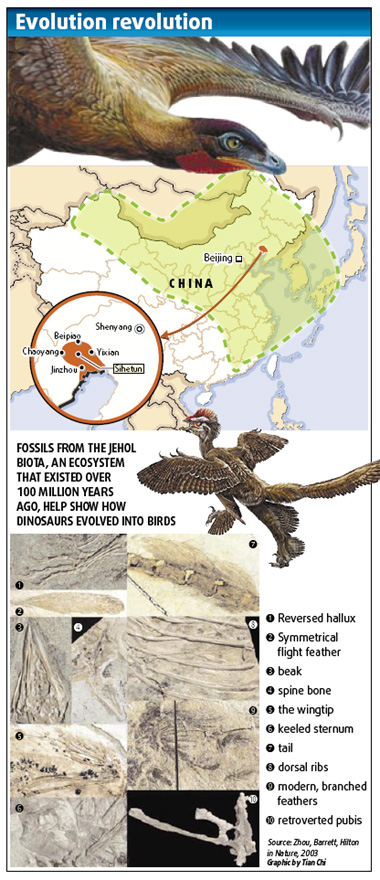Highlights
Walking among dinosaurs
By Dan Chinoy (China Daily)
Updated: 2009-11-24 10:00
But it is unclear precisely how dinosaurs first took flight.
One theory is that small, feathered theropods may have moved off the ground into trees, probably to avoid predators and because they were unable to compete effectively for food with bigger animals.
"If you live in a tree it's safer because lots of big predators can't get you," Xu said. "Also there is lots of food because you can eat fruits, lots of insects living in trees, and some small lizards and mammals. So this is a good niche for small dinosaurs."
A second theory, however, is that dinosaurs learned to fly by running along the ground and flapping their arms to gain speed. This eventually led to gliding, flight and living in trees.
"There's no reason that they had to go up trees to learn to fly. To get into trees is hard. After all, when we humans climb up high, we fall straight down," said Ji. "From our fossil evidence, there is more support for the idea they ran first, because when we look at some of the older fossils, their legs are relatively strong. Their wings are relatively short and the feathers are not totally developed."
There was a catch, however. All feathered dinosaur fossils found so far had been dated after archaeopteryx. Scientists called this problem the "temporal paradox": How could birds have evolved from dinosaurs if bird-like dinosaurs appear in the records after birds themselves?
Then, last month, experts Xu and Hu published an article describing a four-winged dinosaur similar to microraptor called anchiornis huxleyi. This new find was between 151 and 161 million years old - older than archaeopteryx by about 10 million years.
"Now we have this anchiornis that predates archaeopteryx, demonstrating clearly that feathered bird-like dinosaurs are present before the first bird," Xu said.
In other words, the anchiornis find showed that holes in the dinosaur-bird fossil record were more likely the result of the sheer rarity of fossilized feathers than problems with the idea that dinosaurs evolved into birds.
"The keys of evolution lie in dinosaurs. By studying the past, you understand your current situation," said museum director Leloup.
But even Darwin might be startled by what both the evidence and his theory point to.
"When you look at a bird, you can say: This is a dinosaur," said Leloup.
|
 |












